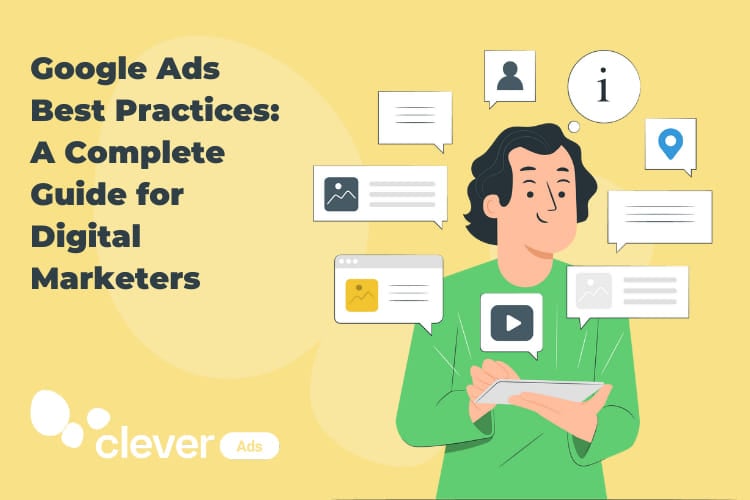Google Ads Best Practices: A Complete Guide for Digital Marketers
Google is easily the most used search engine with almost 4 billion search queries a day. Due to this, there’s no surprise that Google Ads is one of the most popular and effective advertising platforms worldwide. Which means that it is extremely important to know all the Google Advertising best practices out there!
Let’s look at the data:
- Google Ads has been around for nearly 2 decades, and reaches a CTR of almost 8%.
- Google Ads conversion rate is 50% better than organic traffic.
- In 2019, Google advertising revenue was over $116 billion.
- 65% of ads clicked have keywords with a buying intent (ex. “buy”, “for sale”, “shop”, “purchase”, or “get”).
- Advertisers on Google Ads make an average of $8 for every $1 spent.
- More than 90% of Google users see Google display ads worldwide.
- 70% of mobile eCommerce customers place calls through mobile ads.
See the potential? Google can be one of the best and easiest ways to get qualified traffic and well-fitting visitors to your landing pages to generate leads and sales.
However, your work isn’t finished once you have your Google Ads, they need to be continually updated and optimized.
A Google Ads campaign is never completely optimized.
Want to make the most of your Google Ads? In this guide to the best practices for Google Ads, we will cover the 10 most important things to follow when creating and optimizing your campaigns.
We’ll also uncover some of the forgotten practices that still matter if you want to take your Google Ads to the next level.

Google Ads Best Practice #1: Avoid the search network with display extensions
Combining Search and Display networks in the same campaign presents the opportunity to expand your reach and grow your impressions across a broad range of web assets.
With that being said, the results of combining both networks can have negative implications:
- You will end up paying the same price for high intent search traffic and lower intent display traffic, which is usually much cheaper. This can lead you to spending money in an unnecessary manner.
- You would also be using the same ads and messages for those searching for a specific keyword and visitors browsing a website on a completely different topic. It will always be better to have personalized ads depending on the people and places you are targeting.
- It’s not the best course of action to use the same keyword structure for both types of campaigns that require extremely different approaches to segment keyword lists.
Experts recommend splitting up campaigns based on their network targeting and running Search and Display campaigns separately. By not doing so it could lead to large volumes of wasted spend, especially on the display network.
Google Ads Best Practice #2: Implement ad extensions
You should take advantage of ad extensions and implement any that apply to your business.
They are extremely easy to implement and have very good results in terms of improving your CTR and leading conversions. This is due to the function of an ad extension that allows your ad to become more visible as it becomes larger.
There are many types of ad extensions that include different pieces of information and make the ad more effective toward users.

Some are included automatically by Google in your ads, such as sitelink or call extensions. While others are set manually and you can choose to optimize them.
In any case, ad extensions are a great way to boost your ads performance with ease.
Google Ads Best Practice #3: Test at least 3 ads per adgroup
We recommend you include at least 3 quality ads in each of your ad groups, but the more the better!
In doing this, Google Ads will rotate your ads and you will be able to test them with different messages, headlines or call to actions. You can then choose between the better performing ads by checking their performance data. Not only that, but you can stop those that are underperforming and substitute them for new ones to test.
When following this practice, we recommend you create very specific ads and ad groups. For instance, if you sell beauty products, create different ad groups for each of the beauty products you offer. Someone searching for anti-wrinkle beauty products will be more likely to click an ad about anti-wrinkle cream than a generic ad about beauty products.
For the same reason, Google recommends using at least 4 different creative works per ad group for Display campaigns. Banner ads have more to test than headlines and call to actions, so you will need to test more creative measures to strike the right key.
Google Ads Best Practice #4: Properly install your conversion tracking
This might sound obvious, but you would be surprised by the number of Google Ads accounts that aren’t tracking conversions or are doing it wrong without assigning conversion values.
You won’t be able to optimize your ads, headlines, keywords or bids if you cannot track the conversions they bring you.
It’s not as difficult as it might seem, you just need to set up conversion tracking for your website by creating a conversion action and your conversion tracking tag. There are several ways to do it, some of which are very easy.
Once you’ve done this, you should set conversion values. Not all conversions are equal and some will be worth more to your business than others. It won’t carry the same value when someone registers to your newsletter, downloads an infographic or makes a purchase.
You’ll be able to understand both the conversion volume of each of your campaigns, ads or keywords as well as their actual business impact.
Google Ads Best Practice #5: Adjust your bids according to your targeting
You should optimize your targeting in terms of age, gender, location, device and schedule. This will help you show your ads more or less frequently depending on your ad performance for the different targeting options.
If for some reason your campaigns have a better performance on mobile devices with a maximum cost per click of $0.80, then it’s worthwhile to increase your bids for searches on mobile devices to reach more people.
Easy, but you will need to track this continuously to be able to adapt to any changes in the users behavior.
Google Ads Best Practice #6: Keep track of the users’ search terms
The Google Ads search terms report provides you with information about the search terms people have used to find your ads. Tracking these terms will be useful for the following reasons:
- You can discover new keywords for your campaigns that you hadn’t included but are bringing you conversions.
- It helps you identify negative keywords (keywords that are triggering your ads and having a poor performance), which makes you waste money on unqualified clicks that are not driving conversions.
Google Ads Best Practice #7: Be careful with single word keywords
Single word keywords are very broad and may be driving irrelevant traffic to your site while increasing your advertising costs.
You should always keep track of them and verify that they’re bringing you a higher conversion value compared to their cost.
These types of keywords are used when you want to reach a wider audience with general interests. If your objective is to increase your brand awareness, using single word keywords might be beneficial in your strategy.
However, if you want to drive sales and conversions to your business, it’s always better to bid for long-tail keywords.
In any case, keywords of all length and match type should be continuously rotated and optimized like you would do with ads. It will help you save money by stopping underperforming keywords and using new and improved ones. Not to mention, finding new keywords to add to your campaigns can be made easy with the help of our Google Ads keyword planner.
Google Ads Best Practice #8: Banner ads rotation
Just like ads and keywords, rotation is important for banner ads. We highly recommend you periodically rotate and update your creative banner ads so people don’t get used to seeing your ad and start ignoring them.
Google Ads Best Practice #9: Exclude underperforming placements
You should use exclusions to avoid displaying your ads on placements that your target audience is unlikely to visit.
You’ll want to identify these irrelevant or underperforming placements that are not related to your business, ultimately making decisions according to their performance data.
- Clever Tip 1: when excluding placements, try to exclude the specific page and not the entire domain.
- Clever Tip 2: when using remarketing, avoid excluding placements. If someone has expressed interest in your business you’ll want to have as few constraints as possible.
Excluding underperforming placements will help you have better optimized Display campaigns. Your budget will be spent on places where people are interested in what you offer.
Google Ads Best Practice #10: Optimize your landing pages
By not optimizing your landing pages, a low quality score can occur in your Google Ads campaigns. Having a low quality score leads to higher costs and lower ad positions, so it’s important to have it fully optimized.
To obtain a higher quality score you should make sure that your landing page is relevant to the keywords you are bidding for. Google will analyze how well your landing page matches the users search terms to make sure it is relevant and useful to the people clicking on your ad.
In conclusion
Take the knowledge you learned from this post and use it for your store! You’ll be on the road to becoming a Google Ads master by applying all these practices to your Google Ads campaigns.
Lastly, if you are looking for help in optimizing your campaigns we got you covered. Try our Google Ads Audit to instantly discover what you need to optimize and receive ready-to-use tips for you to apply.




